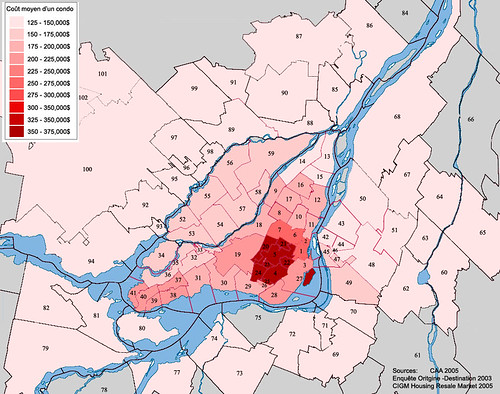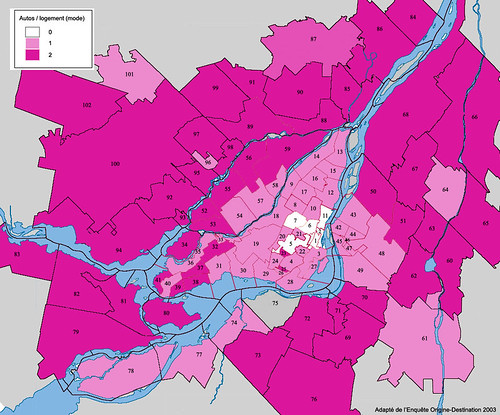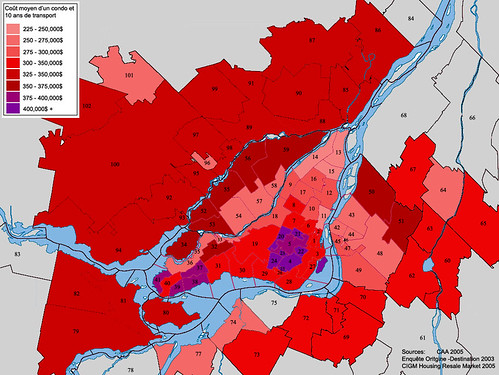
Despite the condos that are popping up all over town, Montreal experiencing a suburban exodus, and loses thousands of families each year to the surrounding areas.
This ad by the City of Montreal, which aims to stop the flow toward the suburbs, brought to mind a study that I did a few years ago, while working on Équiterre’s ecological transportation project. As an educator about alternative transportation, I spoke with many people who claimed that they were “prisoners of their cars” (a direct quote) because they lived in suburban areas that were not serviced by adequate public transit, and too remote to use cycling as a viable means of transportation. Inevitably, these people went on to say that they would love to live in downtown Montreal, but simply couldn’t afford it.
So I crunched some numbers to try and determine whether city-living was truly reserved for a wealthy elite, or whether this was simply a common misperception.
First, take a look at the cost of a housing – the map below shows the price of a 2-bedroom condo in 2005, according stats to the Canadian Housing and Mortgage Corporation.
Note that the CHMC stats group together some boroughs and neighbourhoods such as the Westmount-NDG-CDN-CSL-Outremont blob in the centre of the island, where housing prices are at their highest. A similar map could be drawn for detached houses, although obviously there are far fewer available in the central neighbourhoods. For renters, costs vary much less across the territory.
Predictably, housing gets cheaper the further one moves away from downtown Montreal. But then you have to factor in the fact that, in suburban areas, car ownership is an absolute necessity. In areas with no alternative transportation, many families own 2 or 3 cars to meet their commuting needs. The following map shows the number of cars per household in 2003 (the mode is used in order to display the number of vehicles owned by the majority of families in a given borough).
These statistics are from the Agence Métropolitaine de Transport’s Enquête Origine-Destination 2003. The AMT does this survey every 5 years, and is currently collecting data for 2008. Note that in the Plateau, Rosemont, Hochelaga-Maisonneuve, Cote-des-Neiges and Ville-Marie, the majority of households did not own a car at all in 2003.
The Canadian Automobile Association estimates that owning and driving a car costs $10,000 per year. This is based on 18k km per year and includes gas (at a modest $1 per litre), maintenance, insurance and financing, but does not include parking expenses.
The next map puts it all together. Add the cost of the home to the cost of car ownership over a 10-year period and the cost of living across the territory equals out to a large degree. Not to mention that living closer to downtown can save hours of valuable time each week by avoiding a long commute.
Two things that were not taken into account and which would impact the results are the variation in property taxes, which tend to be higher in central areas, and the number of people per household, which may be higher in the suburban areas. I hope to do a more complete analysis once the 2008 transit stats become available.
Of course the other main hurdle for families seeking urban homes is finding suitable housing. The city recently announced a subsidy of $15,000 per unit for developers who respond to a series of family-friendly criteria. The 1st phase of the program aims to finance 300 new homes, a number which, admittedly, will hardly make a blip in the exodus.




One comment
Very interesting. Obviously there are some limitations to the data and the analysis at this point, but you present a very clear example of the cost of a car and the argument that a number of planners have made for moving toward the core of a city and not away from it. It would be interesting to conduct this study with other Canadian cities. I’m not sure where Montreal ranks on lists of cities with the most expensive real estate. The property tax limitation you mention is also a large barrier to moving toward the core, but I think a system can be designed that rewards housing in the core rather than seemingly punishes them.
Well done.